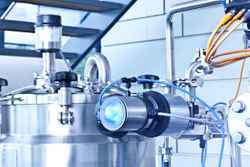
Posted to News on 12th Jul 2017, 12:56
Optimum level and flow control for food industry processes
Process control equipment used in the food and beverage industry has to operate effectively with a wide variety of fluids, granules and powders. Add to this different viscosities and the requirement for a hygienic environment, plus, the ability to keep process lines clean and sterile, then the scale of challenge in managing effective flow and level control in a food processing line becomes apparent. Mark Lilley, Field Segment Manager .Hygienic - Food and Beverage for Brkert Fluid Control Systems, looks at the essential features required to maintain effective and efficient level and flow control.

Level sensors provide vital information, either in the form of an alarm point or as a continuous signal for level monitoring. Depending on the application, a number of different technologies are available to meet the challenges of all types of process environment.
Direct contact sensors, such as float switches and tuning fork sensors offer simple and reliable point level detection options. These discrete sensors are often used in conjunction with continuous level detection sensors to provide alarm signals to prevent over-filling or dry pumping situations.
Non-contact sensors use a variety of technologies, such as ultrasonics, radar, laser, differential pressures and capacitance. Each application may require a combination of these sensors for different processes in order to deliver the most effective solution. Making the most appropriate selection can have a significant effect on the performance and reliability of the manufacturing process.
Selecting the most appropriate level sensor requires a number of variables to be considered especially as increasingly stringent regulations requiring more precise and reliable level measurement, plus safety redundancy. Improvements to the accuracy of process control enables product quality to be increased while also reducing costs and waste.
In contrast to level detection, flow control devices must be in direct contact with the process media and this means that all aspects of the design must enable effective and efficient cleaning processes as well as reliable flow control. With hygiene of the utmost importance within the food industry, being able to implement an effective and efficient cleaning process is essential to meet the required standards.
Hygienic applications
Fluid control systems within hygienic applications demand high standards in terms of cleanability which can be affected by a number of design characteristics. Clean-in-Place (CIP) and Steam-in-Place (SIP) systems are designed for automatic cleaning and disinfecting without major disassembly of the process line.
The base material is normally 316L stainless steel which requires an excellent surface finish in order to maximise the efficiency of the CIP process that is used to sterilise the process pipework. Coupled with excellent thermal properties, the design of process valves has become a complex process; some of the latest products use technologies such as hydroforming to deliver a number of process advantages.
By reducing the overall weight of a valve housing, the energy and time required to complete the cleaning process can be reduced, improving efficiency and maximising productivity. The reduced volume of material means that the energy requirement for both heating and cooling during cleaning processes is greatly reduced.
Similar attention to detail should also be paid to the valve actuator, which should also meet prescribed standards for both hygiene and energy efficiency. The use of stainless steel in the general construction of the actuator goes a long way to avoid issues such as rust, corrosion and flaking paint in a hygienic environment.
With many valves using pneumatic control, the internal design of the actuator can have a significant effect on the overall air consumption and consequently the energy required to operate a series of control valves. Coupled with intelligent valve controllers and a decentralised control arrangement, it is possible to use a common air supply to a number a valves, reducing the overall air consumption.
Ultimately, the key to implementing the most appropriate valves and sensing equipment in a food manufacturing process is to make use of expert advice and advances in modern design. As energy efficiency and productivity become even more important, so the use of bespoke products enables these goals to be met.
Fortunately, help is at hand from the experienced engineers at Brkert, who have considerable expertise in designing and installing process control systems for a wide variety of applications. Further information about Brkert, the wide range of sensors and other fluid control devices can be found at www.burkert.co.uk.
Fluid Control Centre
1 Bridge End
GL7 1QY
UNITED KINGDOM
+44 (0)1285 648720






























